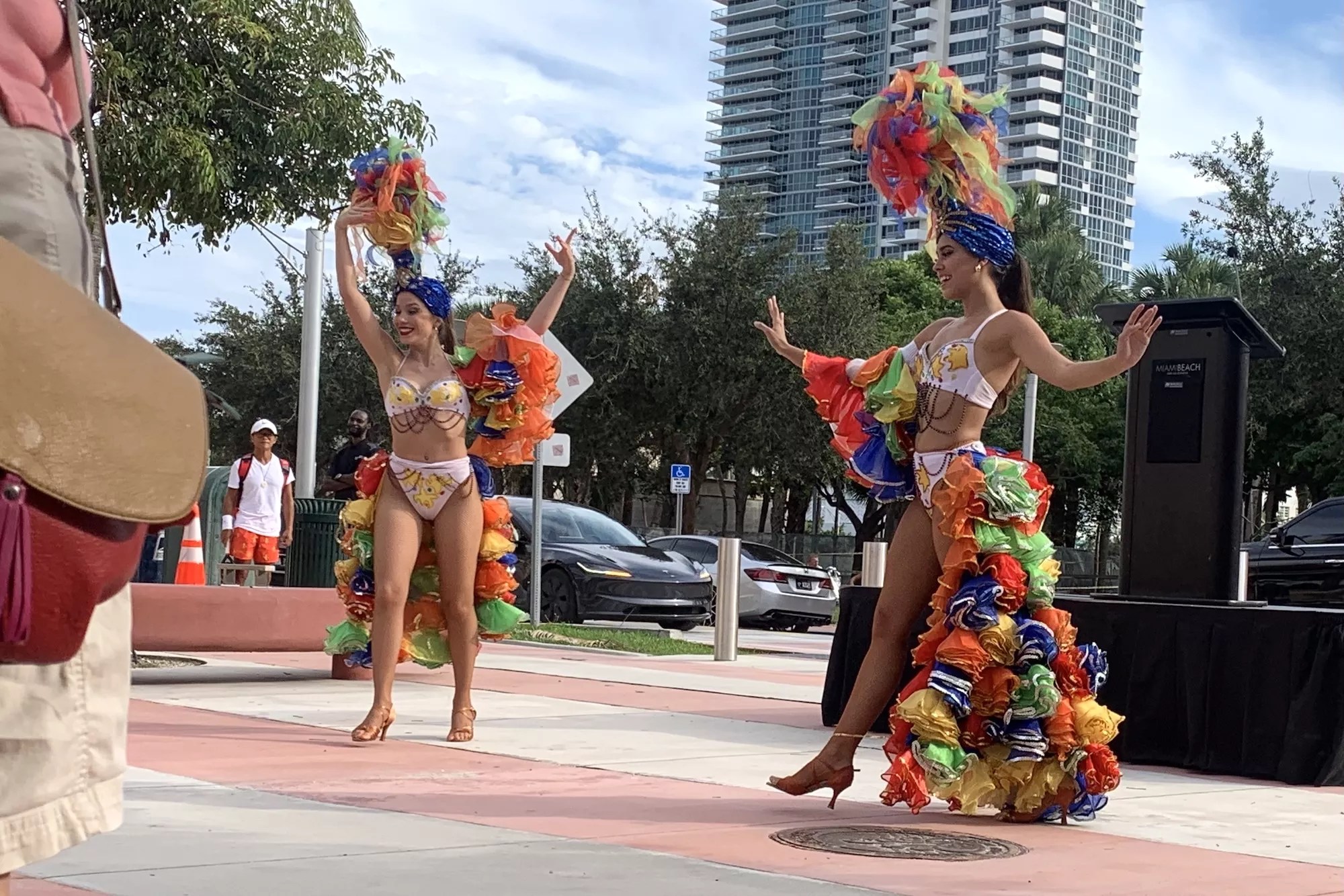
Raj Tawney photo

Audio By Carbonatix
On Tuesday, October 15, the City of Miami Beach dedicated a historical marker to Cuban-American entertainer Desi Arnaz, known by most people for playing Lucille Ball’s bandleader husband, Ricky Ricardo, on the beloved 1950s TV sitcom I Love Lucy. Though he’s becoming a distant memory in our cultural zeitgeist and often treated as a Hispanic caricature, accent and all, Arnaz’s journey and life story were both inspiring and tumultuous – all the makings of a fascinating figure worth honoring and revering.
The marker unveiling took place in the late afternoon – too early for those with 9-to-5 jobs to attend but prime time for Miami Beach’s senior citizens, wealthy class, and curious tourists roaming the grounds.
The marker was cemented in the pavement at the corner of Collins Avenue and 23rd Street, directly in front of the entrance to the Miami City Ballet, the location of the former Park Avenue Restaurant where Arnaz’s “dance of desperation” in 1937 famously took him from being struggling unknown Miamian to the face of the conga craze that would sweep the nation in the years to follow. But the reason Arnaz arrived in Miami in the first place echoes the desperation of many Cuban refugees seeking asylum.
Although Arnaz came from a wealthy political family, the Cuban Revolution of 1933 completely destroyed their lives. Desi’s father, along with other party leaders, was thrown into prison while he and his mother managed to find their way to Miami, where the family would slowly start their lives over without any money in their pockets. With the help of his father’s friend, Desi was able to attend St. Patrick’s High School in Miami Beach and taught himself English, too. An aspiring musician, he caught the attention of Spanish bandleader Xavier Cugat and worked his way up the ranks, eventually starting his own band in Miami, and, well, the rest is history. And Desi is a piece of Miami’s history worth remembering and celebrating.
Miami, make your New Year’s Resolution Count!
We’re $16,000 away from our End-of-Year campaign goal, with just a five days left! We’re ready to deliver — but we need the resources to do it right. If Miami New Times matters to you, please contribute today to help us expand our current events coverage when it’s needed most.

Dancers from La Perla musical revue performed during the dedication ceremony for the Desi Arnaz historical marker.
Raj Tawney photo
A marker dedication ceremony isn’t as glamorous as the person and the era being paid the tribute, but the performers from the musical revue La Perla, who perform regularly at Havana 1957, put on a delightful rhythmic dance to an original recording of Arnaz’s “Holiday in Havana,” but not before the crowd sat through multiple speeches by local city officials who spouted the same rhetoric about Arnaz being a “trailblazer” and “inspirational” Cuban-American. The only standout was Miami Beach Commissioner Tanya K. Bhatt, who spoke eloquently and passionately about the significance of the occasion and read a note sent in by Desi’s daughter, Lucie Arnaz Luckinbill. Then, finally, writer and lecturer Gary McKechnie, the sole person who campaigned for the marker for the past two years, gave a heartfelt speech and provided some vital historical background to those in attendance who may not have known much about Arnaz.
I was honored to introduce Gary to the mic, but not before he asked me to read aloud a note written by actor Keith Thibodeaux, who played Little Ricky on I Love Lucy and remembered his TV dad fondly. It was a surreal feeling as I’d previously written about how I saw myself in Little Ricky when I was growing up, being the son of an interracial marriage with an immigrant father who also had a thick accent and was wildly charismatic. It was a moment I’ll never forget.
Following the festivities, Gary and the politicians gathered around the marker, hiding behind a blue satin covering for the unveiling. The public servants were in their glory as cameras snapped away, optimizing their photo ops as the countdown began. I stood in the background, among the other citizens and political staff (Why do the staff always look so busy and stressed, by the way?), staring at the cast iron marker, the headline reading: “Desi Arnaz (1917-1986) An American Original.” Tears came to my eyes. Nobody else mattered in that moment but Desi and what he meant to millions of others and me.
And just then, as we were standing there, two young tourists – one from Germany, the other from Portugal – who had met in a hostel only hours earlier and were now exploring the city together approached my wife Michelle and me, asking who Desi Arnaz was. We tried to explain. They hadn’t seen or heard of I Love Lucy or any of the recent film projects, including Meet the Ricardos (2021) or Lucy and Desi (2022), but that was okay. The marker was already doing its job and fulfilling its purpose – to educate current and future generations about who came before us, as well as what was and is possible in the United States. It was a moment to savor.
I’d like to think Desi was smiling down on Miami Beach that afternoon, palm to his cheek, murmuring “Ay yi yi yi yi” to himself. I hope so.
To learn more about the historical marker and McKechnie’s efforts, visit thankyoudesiarnaz.com and graciasdesiarnaz.com.